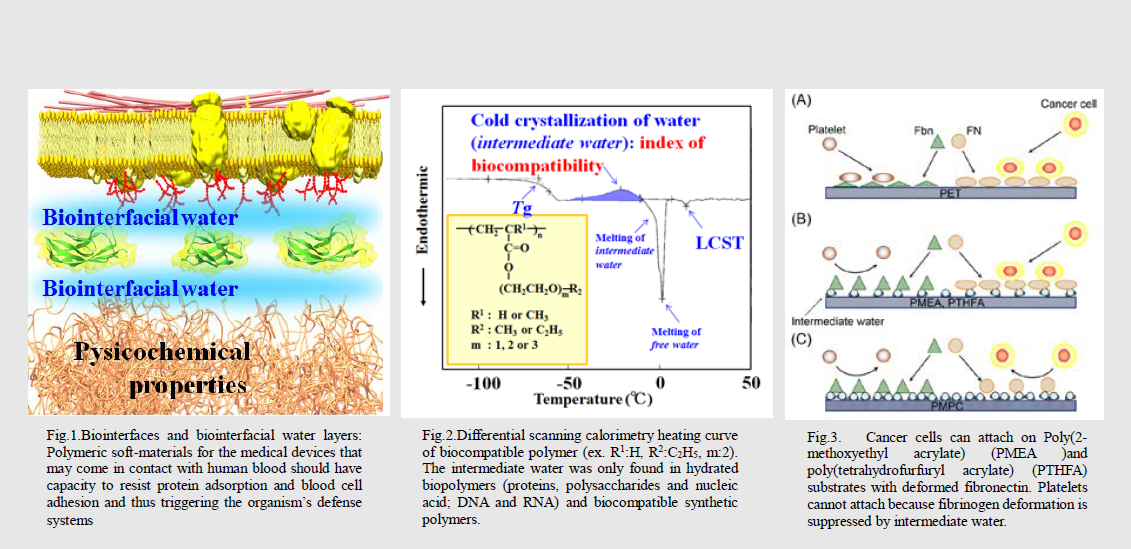IMCE
Institute for Materials Chemistry and Engineering, Kyushu University
九州大学
先導物質化学研究所

LAST UPDATE 2017/02/25
-
研究者氏名
Researcher Name田中賢 Masaru TANAKA
教授 Professor -
所属
Professional Affiliation九州大学先導物質化学研究所
ソフトマテリアル部門 ソフトマテリアル学際化学分野
Institute for Materials Chemistry and Engineering, Kyushu University
Soft-materials chemistry -
研究キーワード
Research Keywords生体適合性
細胞接着
バイオ界面
水和構造
Biocompatibility
Cell adhesion
Bio-interfaces
Water structure
- 研究テーマ
Research Subject -
生体適合性に優れた診断・治療用ソフトバイオマテリアルの設計
Design of biocompatible soft-biomaterials for medical devices
研究の背景 Background
高分子ソフトバイオマテリアルは、高齢化社会において重要な役割を担っている。生体親和性と生分解性を有する高分子は、診断・治療用の医療製品開発のブレークスルーのためには必須である。高分子ソフトバイオマテリアルと水・イオン・タンパク質・微生物・細胞などの生体成分の相互作用の理解と制御が、バイオメディカル製品開発の最重要項目である。
Polymeric soft-biomaterials have significant impact in the aged society. Biocompatible and biodegradable polymers have emerged during the past decades to promise extraordinary breakthroughs in a wide range of diagnostic and therapeutic medical devices. Understanding and controlling the interfacial interactions of the polymeric soft-biomaterials with biological elements, such as water, ions, proteins, bacteria, fungai, and cells are of essential towards their successful implementation in biomedical applications.
研究の目標 Outcome
合成高分子バイオマテリアルの生体適合性発現機構の分子レベルで理解するために、材料と生体成分が接触する環境に存在する水分子に着目し、中間水コンセプトを提案している。本研究では、主鎖、側鎖を系統的に変化させた高分子を精密合成することでバイオ界面水を制御し、次世代の診断・治療用医療機器のための分子設計指針の構築を目指しています。
In order to understand the underlying mechanisms for the biocompatibility of polymers at the molecular level, we have proposed the “Intermediate Water” concept. The intermediate water behaves differently from bulk water and acts as a physical barrier against protein adsorption and platelet adhesion. The objective of the research is to design of the multi-functional biomedical polymers by controlling bio-interfacial water structure through precision polymer synthesis.
研究図Research Figure

文献 / Publications
ACS Biomater. Sci. Eng, in press, Macromolecules, in press, Biomacromolecules, in press. Macromolecules, 49, 2493-2501, (2016). ACS Appl. Mater. Interfaces, 7, 18096-18103, (2015). Langmuir, 31,7100 (2015).
Langmuir, 31, 3661 (2015). Adv. Healthcare Mater, 3, 775 (2014). Nanomedicine, 10, 313 (2014). Langmuir, 30, 10698 (2014). Polym. J., 47, 114 (2015).
研究者HP
- masaru_tanaka
 ms.ifoc.kyushu-u.ac.jp
ms.ifoc.kyushu-u.ac.jp - http://www.soft-material.jp/